Since my post on Green roofs in Seoul, more green things have been found! I have realized that this seems to be the same green paint that is also used everywhere on many things (other than roofs). It appears in carparks in Seoul, under bridges, on the side of highways, and notably it is also used to paint the paths for walking along rivers and canals (sometimes they use the squishy green sponges too, but other times I think it is just green paint to say "HEY LOOK ITS A GREEN FOOTPATH!"...
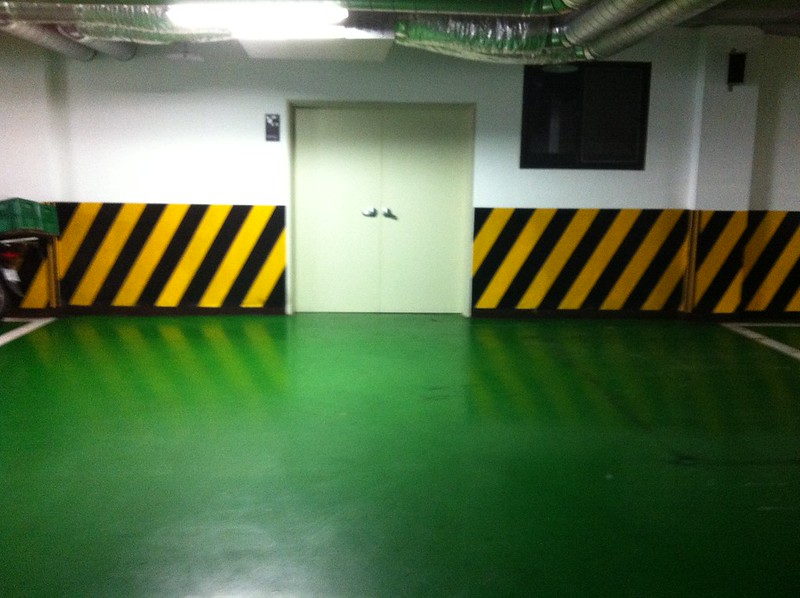
Green carpark
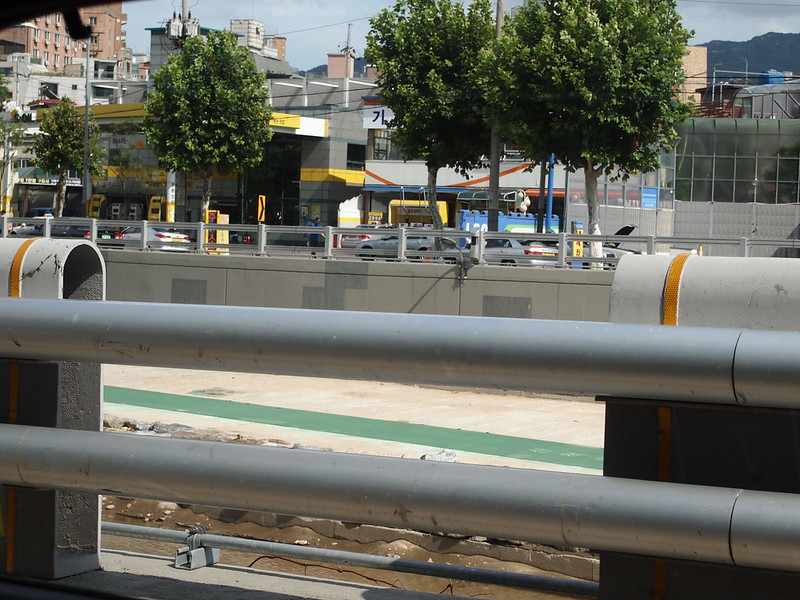
Green footpath along canal
Murim, one of the curators at Mullae, also suggested that the reason for favoring the green paint is because of cost considerations. That the green waterproofing paint is cheaper than other paints, hence its popularity with cost-concious developers. What do you all think? Can anyone offer up an actual price comparison between green waterproofing paint and white/gray waterproofing paint?
Another small distinction that should be made is that the green parts actually tend to be human accessible places. After staring out of the window and trying to figure out why there is only one big green roof amidst blue ones, it suddenly dawned upon me that all the blue roofs are true rooftops, the only green part that I see is at the human accessible portion of the rooftop!
On Sunday we went to see a traditional korean house, and on Monday we went to see what apartments typically to look like in Korea. We also went to the Seoul National University library (Heewoo studied at SNU) to see if there were any books on apartment block buildings in Seoul. Most of the books were in Korean but I was heartened to see so much literature and books written in Korea, some in what appeared to be very specialised topics. I've always thought that I could never learn a language (or have a genuine interest in learning the language) if it did not have a good body of literature and certainly Korean to me is one language that would be worth learning.
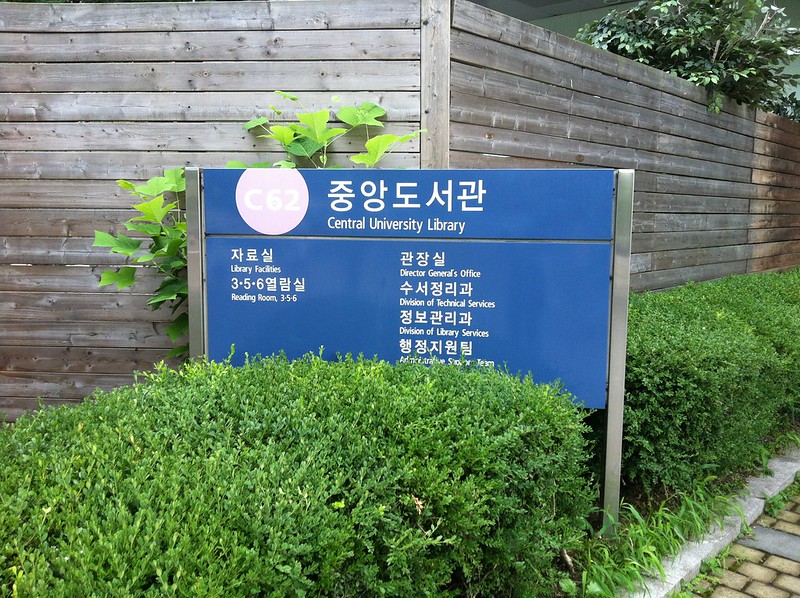
SNU Central Library
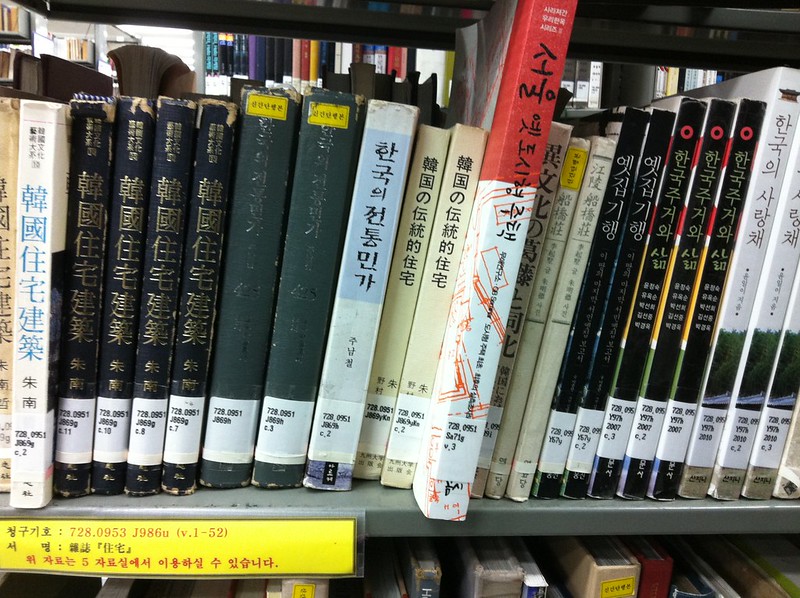
Books on Korean Dwellings
There were a number of books that looked interesting but were all in Korean. It seems there is very little english material on the nature of Korean apartments. One of the good books was 콘크리트 유토피아 (concrete utopia) by 박해천. It had many amazing aerial shots (which also showed many green roofs, by the way). There was also an old book from 1989 that was apparently a contest that was held for designer to come up with ideas for building apartment blocks for low-income housing. It had many pictures in it of building plans but we could not tell from looking at the book whether any of these "utopian" low-income high-density buildings were ever built in Seoul, although they did look very generic:
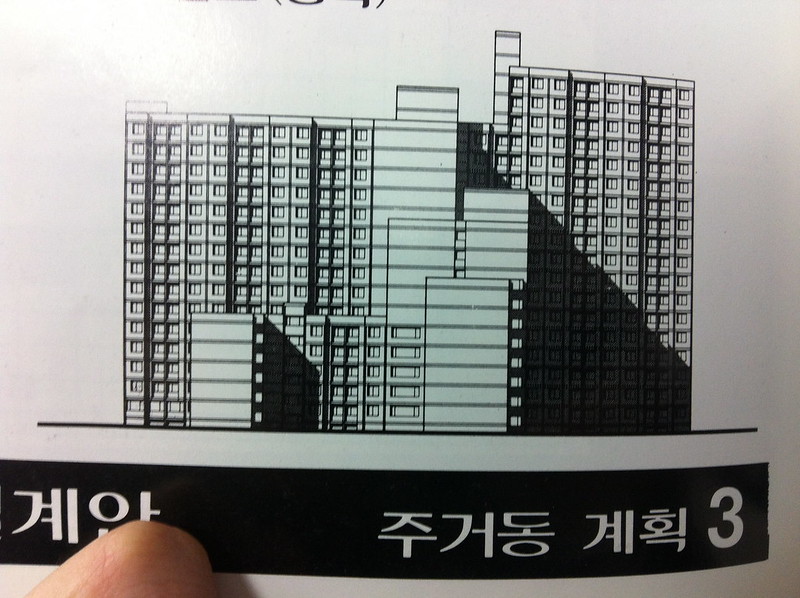

Looking at apartment blocks, we also have seen many blocks with vertical line patterns on their sides. I wonder why this is so? Possibilities envisioned so far are as follows:
1. structural - to use vertical structures to improve vertical strength of side wall?
2. visual design - to use strong vertical lines to emphasize great height
3. cultural disposition for strong geometric lines on buildings?
4. preference for buildings that face north and south with no facings to east and west - resulting in two side walls without windows and a big wall on the side which needs some cheap and simple design which helps break up the monotony by not being entirely flat?
Here are a couple of apartment blocks that we have seen over the last 2 days. Take note of the vertical lines on the sides of almost all of the buildings. Note these aren't low-income housing, some of these are probably quite large on the inside:
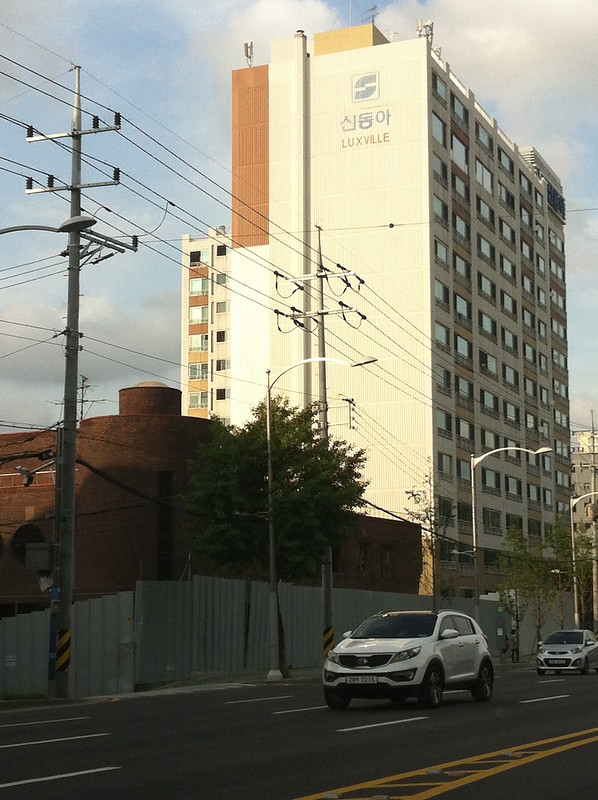
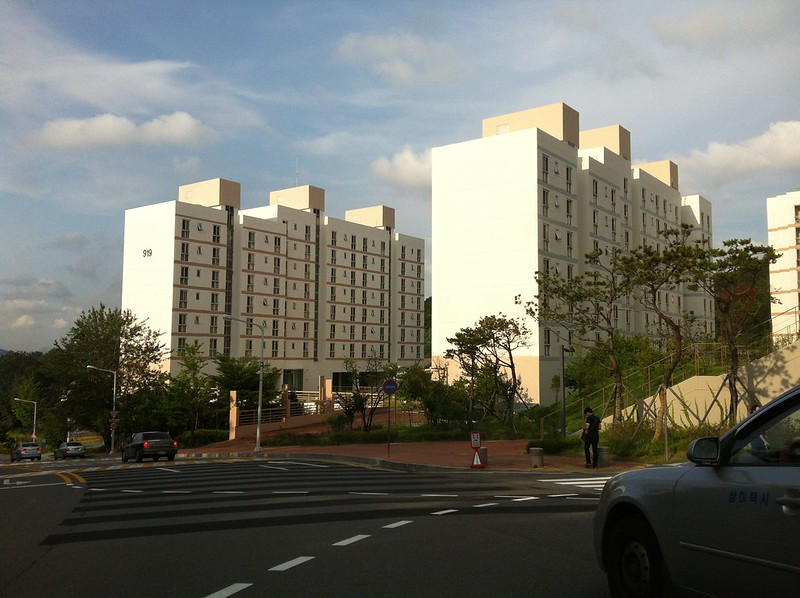
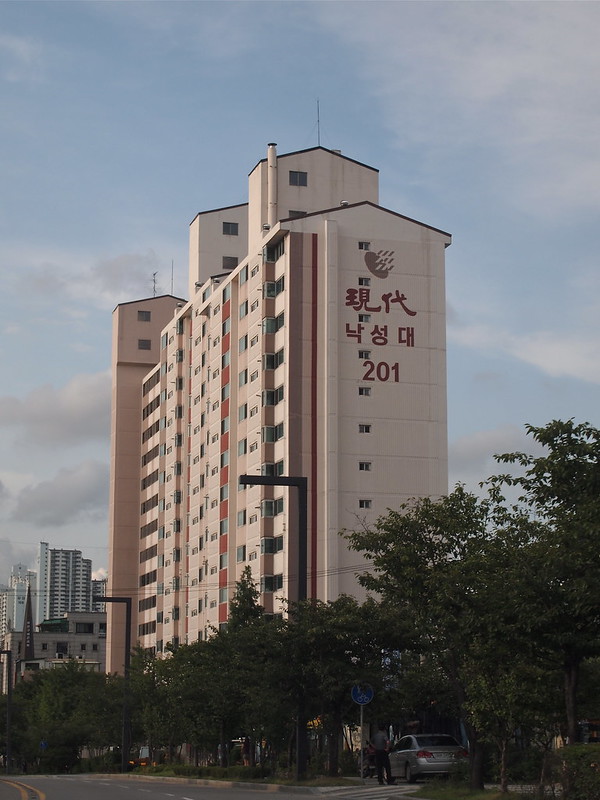
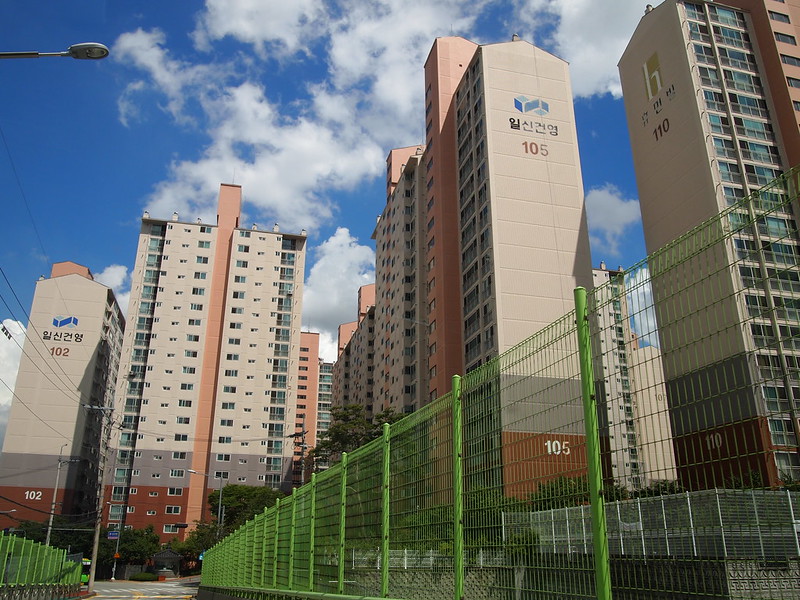

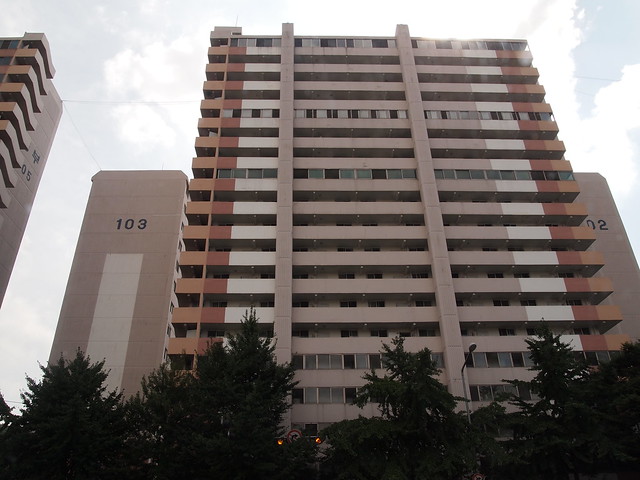
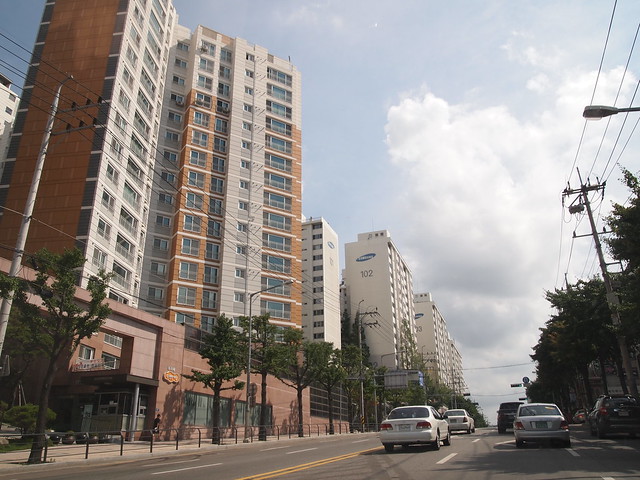

Green carpark

Green footpath along canal
Murim, one of the curators at Mullae, also suggested that the reason for favoring the green paint is because of cost considerations. That the green waterproofing paint is cheaper than other paints, hence its popularity with cost-concious developers. What do you all think? Can anyone offer up an actual price comparison between green waterproofing paint and white/gray waterproofing paint?
Another small distinction that should be made is that the green parts actually tend to be human accessible places. After staring out of the window and trying to figure out why there is only one big green roof amidst blue ones, it suddenly dawned upon me that all the blue roofs are true rooftops, the only green part that I see is at the human accessible portion of the rooftop!
On Sunday we went to see a traditional korean house, and on Monday we went to see what apartments typically to look like in Korea. We also went to the Seoul National University library (Heewoo studied at SNU) to see if there were any books on apartment block buildings in Seoul. Most of the books were in Korean but I was heartened to see so much literature and books written in Korea, some in what appeared to be very specialised topics. I've always thought that I could never learn a language (or have a genuine interest in learning the language) if it did not have a good body of literature and certainly Korean to me is one language that would be worth learning.

SNU Central Library

Books on Korean Dwellings
There were a number of books that looked interesting but were all in Korean. It seems there is very little english material on the nature of Korean apartments. One of the good books was 콘크리트 유토피아 (concrete utopia) by 박해천. It had many amazing aerial shots (which also showed many green roofs, by the way). There was also an old book from 1989 that was apparently a contest that was held for designer to come up with ideas for building apartment blocks for low-income housing. It had many pictures in it of building plans but we could not tell from looking at the book whether any of these "utopian" low-income high-density buildings were ever built in Seoul, although they did look very generic:


Looking at apartment blocks, we also have seen many blocks with vertical line patterns on their sides. I wonder why this is so? Possibilities envisioned so far are as follows:
1. structural - to use vertical structures to improve vertical strength of side wall?
2. visual design - to use strong vertical lines to emphasize great height
3. cultural disposition for strong geometric lines on buildings?
4. preference for buildings that face north and south with no facings to east and west - resulting in two side walls without windows and a big wall on the side which needs some cheap and simple design which helps break up the monotony by not being entirely flat?
Here are a couple of apartment blocks that we have seen over the last 2 days. Take note of the vertical lines on the sides of almost all of the buildings. Note these aren't low-income housing, some of these are probably quite large on the inside:







No comments:
Post a Comment